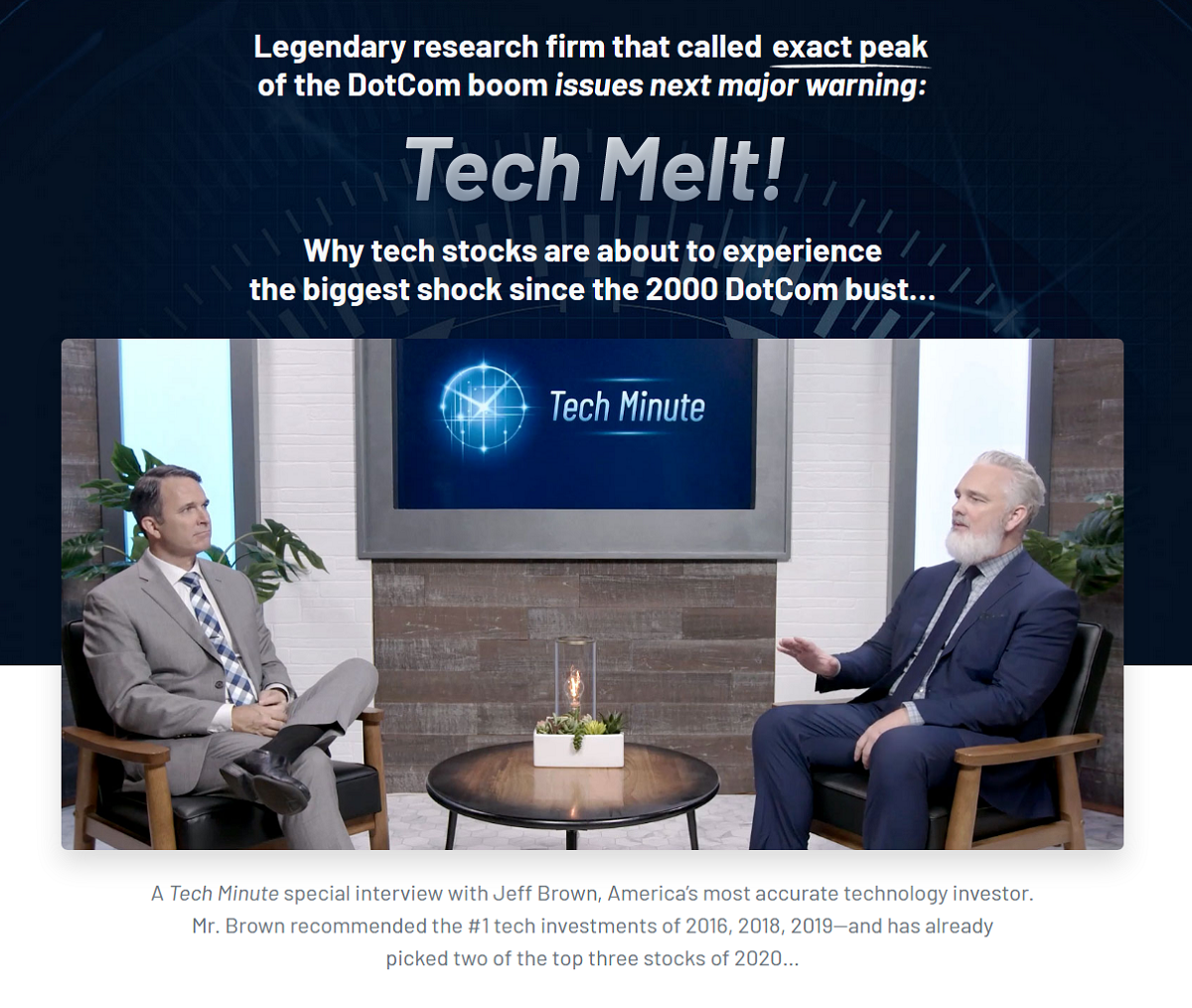In a recent Jeff Brown Second Wave: Tech Melt 2020 video presentation, Jeff Brown joined the host to talk about this new opportunity detailed in Near Future Report, being called the Second Wave Prediction.
Click Here to Watch Jeff Brown’s Second Wave Prediction
Table of Contents
Jeff Brown Second Wave: Tech Melt
In a normal year, yesterday would have been one of the biggest annual events in the tech world – Apple’s September new product announcement.
Of course, this year’s iteration was virtual. And something was missing…
The new iPhone.
That wasn’t a big surprise. Apple had been signaling that the new 5G-enabled iPhones would be delayed by at least a month due to the supply-chain disruptions earlier this year. And that’s the reason for the absence of the iPhone.
But I see something very different…
Apple’s product lineup has grown so much, with so many market leaders, that each one could basically justify its own product event. That’s especially true for the iPhone.
Apple has sold more than 500 million iPads over the last 10 years, and the product just keeps getting better. The eighth-generation iPad was announced with semiconductors specifically designed to use a form of artificial intelligence (AI) called machine learning.
This technology will be used for augmented reality, advanced graphics, and more new applications that will follow.
The new Apple Watch Series 6 was released with the addition of new sensors on the back capable of measuring blood oxygen levels. The new product has become a serious tool for health monitoring, and it is designed tightly with another new product, Fitness+.
We should remember, Apple now outsells the entire Swiss watch industry. That includes low-end watches like Swatches.
Fitness+ is a new personalized fitness application to support consumers and their workout routines. Apple will use the platform to deliver training classes to its subscribers. We can think of it like a subscription service along the lines of what Peloton offers to those who buy its stationary bikes.
And that was the big news – its subscription-based business. Apple announced its Apple One subscription plan, which will include its Music, TV+, Arcade, News+, Fitness+, and iCloud services in a bundle.
In one fell swoop, Apple is making a move to push out Netflix, Hulu, Spotify, direct news subscriptions, media storage, and fitness subscriptions – and all for just $29.95 a month.
It’s smart… and it’s going to be a big hit.
When the new 5G-enabled iPhone is announced next month, we should expect another tier of the Apple One subscription plan that includes the latest iPhone.
No need to “buy” the phone anymore. It will come as part of the Apple One plan for an additional $40–50 a month. The phone will be automatically upgraded every two years. These are just my predictions, but I’d be shocked if this isn’t what Apple has in mind.
I can’t wait for the new 5G iPhone. It’s the inflection point that we’ve been waiting for…
Now let’s turn to our insights…
— RECOMMENDED —
Why Everyone is Getting Rich Right Now … And You’re Not
Thousands of Americans have been hit by a wave of wealth in the wake of COVID-19. Stocks are up 40% since the crash, yet some lucky retirees have the opportunity to see 100%+ gains because of what’s coming next. How are they doing it?
For the first time in history, two millionaire investors have joined forces to help you learn the secret moneymaking strategy of the wealthy and connected.
Click here to watch their presentation
Jeff Brown’s Near Future Report: Avoid This Overhyped Stock at All Cost
We talked about electric vehicle (EV) startup Nikola (NKLA) back in June after it went public. Nikola strategically chose the first name of famous inventor Nikola Tesla, and it is working on electric pickup trucks and semitrailers.
Since going public, Nikola has shot up to a $13 billion valuation. That puts it on par with companies like our Near Future Report holding Qorvo and the popular real estate marketplace Zillow.
But Nikola hasn’t built or sold a single truck yet. It has no meaningful revenue. So the lofty valuation doesn’t make much sense to me.
And that’s why a new deal that Nikola struck with legacy carmaker General Motors (GM) is so interesting.
GM is taking an 11% stake in Nikola and receiving about $2 billion in stock. In return, Nikola will use GM’s battery technology in its trucks. And GM will manufacture Nikola’s trucks in one of its existing facilities.
So GM is going to make Nikola’s trucks and supply them with its EV battery technology. What does that make Nikola?
To answer that, let’s compare it to Tesla (TSLA).
Tesla is one of the world’s most successful artificial intelligence (AI) companies. The AI Tesla has developed and trained is a large part of what makes the company so valuable.
At the same time, Tesla designs its own batteries, which allows it to incorporate the latest advancements in battery technology, as we’ve written about before. Tesla also manufactures cars in its own bleeding-edge manufacturing facilities.
Meanwhile, Nikola is going to pay one of the least efficient carmakers in the world to manufacture its trucks. And it is going to use battery technology that lags far behind Tesla’s.
To me, that makes Nikola nothing more than an auto design company.
And do we think GM can make Nikola’s trucks with bleeding-edge technology at low cost? I doubt it.
GM has fallen behind on the EV trend and is desperate to catch up. Nikola sees this as the fastest way to get its trucks to market. That’s why the deal appears to make sense for both parties.
My take is that GM is going to lose big on its investment, and investors are going to find out painfully that Nikola is not what it appears to be…
And to make matters worse, the Securities and Exchange Commission (SEC) is now investigating a short-seller’s allegation that Nikola misled investors with fraudulent claims.
As I said back in June, investing in Nikola at these levels would be a quick way to lose a lot of money. My advice is to ignore the hype and steer clear.
And Nikola isn’t the only “toxic” stock to watch out for. I’ve recently put together a presentation where I discuss a handful of hyped stocks you absolutely don’t want in your portfolio.
Go right here to find out more.
Why a team of researchers sent mice into space…
A team at the Jackson Laboratory in Connecticut just released research on a group of 40 mice sent to the International Space Station (ISS) last December. We may ask – why in the world are they sending mice to space?
Well, one of the big challenges that astronauts have is that they lose muscle mass and bone density while they are out in space under zero gravity. That’s why astronauts must work out for hours every day just to maintain their physiques. If they didn’t, they would come back to Earth in a greatly weakened state.
But this team at Jackson Laboratory believes genetic editing can solve the problem. The team developed a gene-editing technique to remove myostatin, which is a protein that limits muscle growth.
And that’s where the mice come in…
Of the 40 mice sent into space, eight of them were edited to remove myostatin. Another eight were given an injection that would inhibit both myostatin and activin A, which also affects muscle development. The other 24 mice were not edited.
Upon returning to Earth, the 24 unedited mice had lost significant muscle mass and bone density. The eight genetically-edited mice retained most of their muscle mass and bone density. And the eight mice who had both myostatin and activin A inhibited came back to Earth with no noticeable losses at all.
To take the study a step further, the treated mice experienced faster recovery after returning to Earth when compared with the untreated control mice, which continued to lose bone density for a time even after reentering Earth’s gravity.
So this gene-editing treatment was a great success.
The research paper outlining the study was published in Proceedings of the National Academy of Sciences. In it, the research team concluded that this technique could work in humans as well.
Of course, that has profound implications for our space exploration ambitions. But this treatment isn’t limited to astronauts…
It could also be a miracle therapy for patients on Earth whose muscles have atrophied. If we think about older patients who are bedridden or confined to a wheelchair due to illness, this could help them recover and retain muscle mass, which would greatly improve their quality of life.
— RECOMMENDED —
Want the chance to put $2,500, $5,000, $10,000, or more in your pocket every Thursday?
Jeff Brown’s Second Wave Prediction
We talked back in March about how the COVID-19 pandemic was slowing down the internet.
With many people around the world stuck at home in an economic lockdown, internet usage spiked as much as 20–40% in just a few weeks. And some applications, like videoconferencing and gaming, more than quadrupled.
In that March issue of The Bleeding Edge, I said that COVID-19 would be great for us as tech investors.
And in my premium research services, I removed all stop losses and refused to sell any positions. I said it would be foolish to sell in panic when we owned the very companies with the most to gain from the pandemic.
It sounded crazy at the time to some. After all, the Nasdaq Composite had just crashed 30%, and the mainstream media was predicting that millions of people were about to die.
But it was easy to see that COVID-19 was the catalyst for a major shift to a digital-first world. And of course, that benefits the tech sector more than any other industry.
What I was most curious about at the time was how the data center industry was responding to the internet boom. How much were companies spending to build out their infrastructure to accommodate the massive shift in the market?
And I just got the answer to that question.
The numbers show that revenues spiked nearly 20% year-on-year across the top five server companies in the second quarter. We’re talking about companies like Hewlett-Packard, Dell, Inspur, Lenovo, and IBM.
This tells us that companies were scrambling to upgrade their infrastructure in the second quarter. Server hardware was flying off the shelves at the height of the pandemic.
And the numbers show that demand for common, low-end servers grew 22% in the second quarter. These are the servers that are the backbone of the internet.
Meanwhile, demand for high-end servers jumped 44%. These are the servers that power mission critical systems as well as artificial intelligence and machine-learning applications.
It’s remarkable to see this kind of growth in server hardware. This quantifies the COVID-19 internet boom, and it shows us that the industry will scale quickly to handle increasing demand.
After all, these gains came amid the worst of the economic lockdowns. We can expect sustained investment to meet the continuing growth in the sector due to what will clearly become a different work environment post COVID-19.
And with the Nasdaq Composite now up about 62% from its March lows, we clearly made the right decision to sit tight back in March while the rest of the world was panicking.
— RECOMMENDED —
HOW TO TRADE STOCKS RIGHT NOW FOR AN EXTRA $1,000 A MONTH
GET FREE 3-day Video Trading Series Showing You How to Start Making an Extra $1,000 a Month.
Jeff Brown’s 4X Window Event: Penny IPO Picks
I’ve uncovered a way for everyday investors to gain access to early stage technology companies without having to buy pre-IPO shares. It has to do with a secret class of stocks that I call “Penny IPOs.”
In my more than 30 years researching, writing, and investing in technology, this could be the most important breakthrough I’ve uncovered to date.
For “Main Street” investors looking to gain access to early stage tech companies and see explosive returns quickly, this is the best way I know how.
I spent more than five years fine-tuning a system for trading these Penny IPOs. And my system tells me that we are now entering a special period for this tiny class of stocks. It’s something I call the “4X Window.” And it is going to send these stocks into hyperdrive.
To pull back the curtain on this opportunity and how to capitalize on it, I am hosting an event on September 23 at 8 p.m. ET. There, I will show you how a small investment in this class of IPOs can reap major gains in the coming months.
For readers who would like to learn more, simply go right here to reserve your spot.



